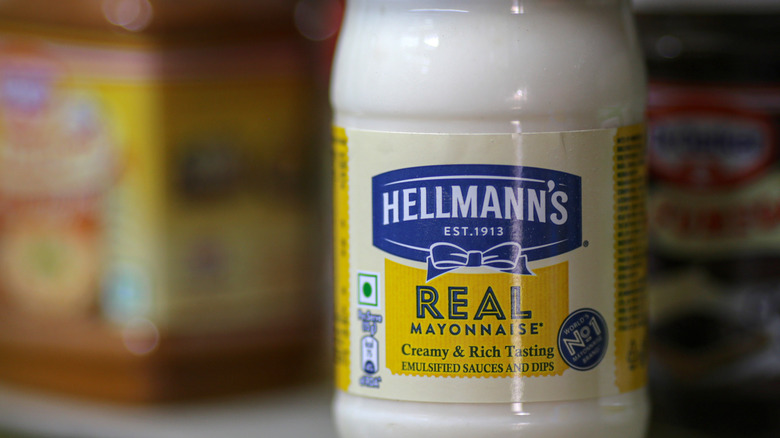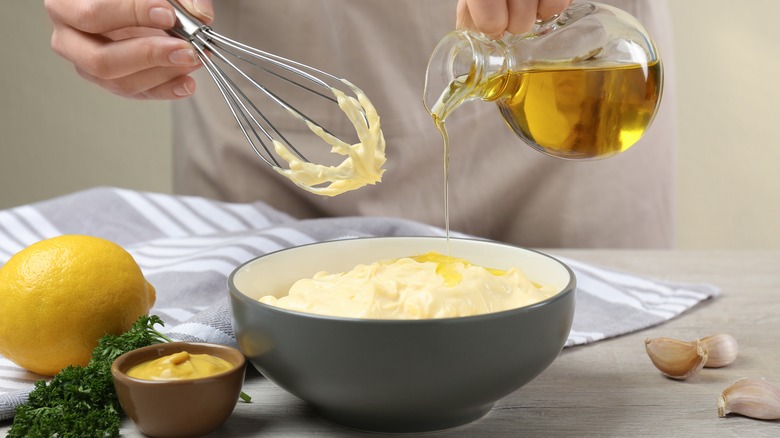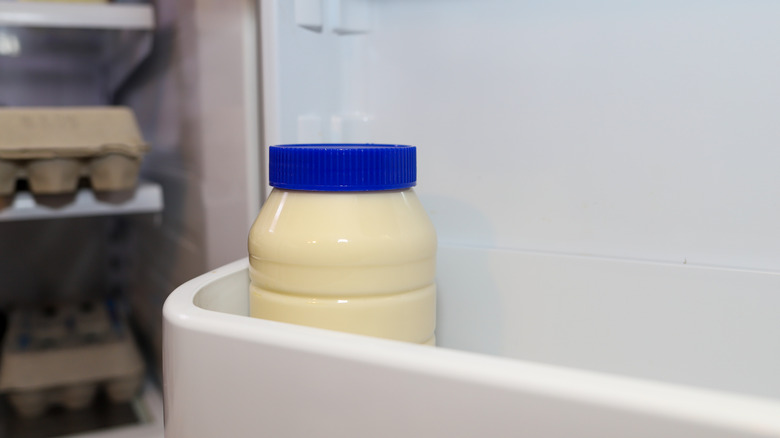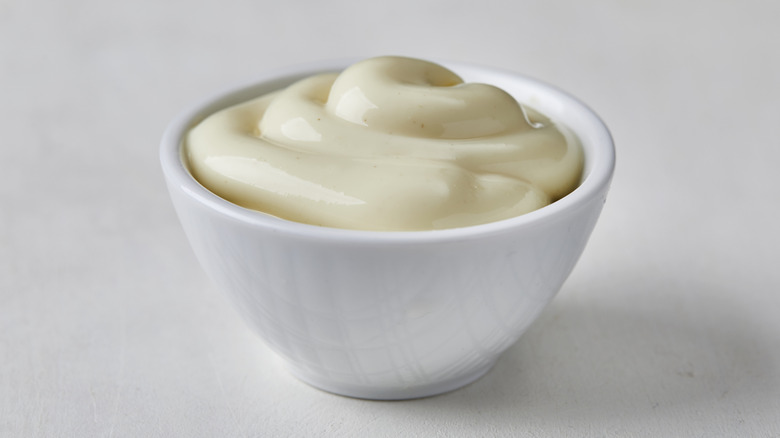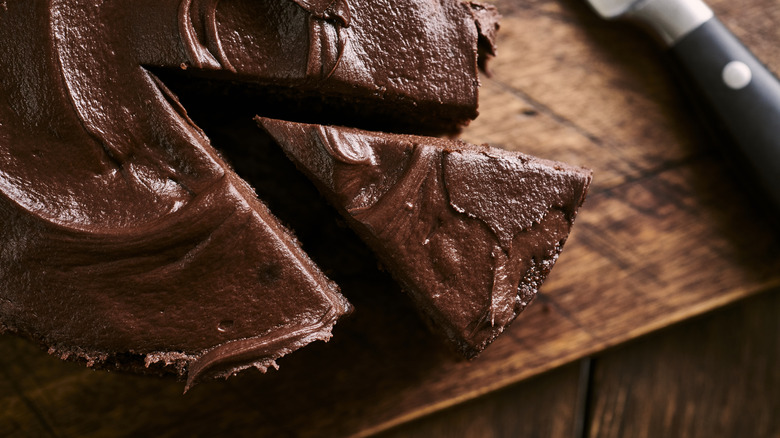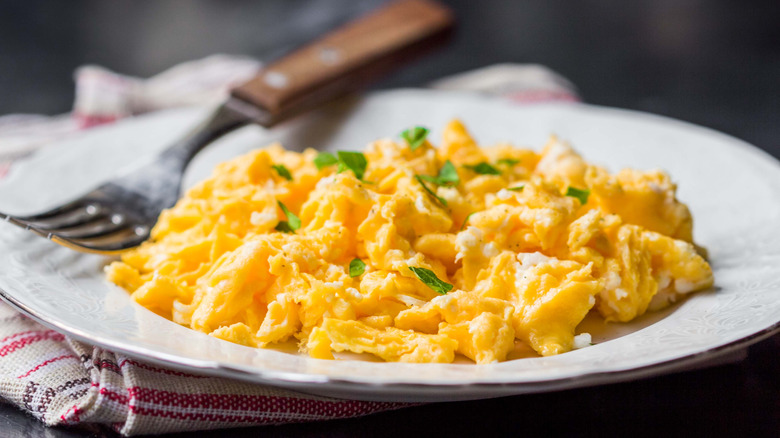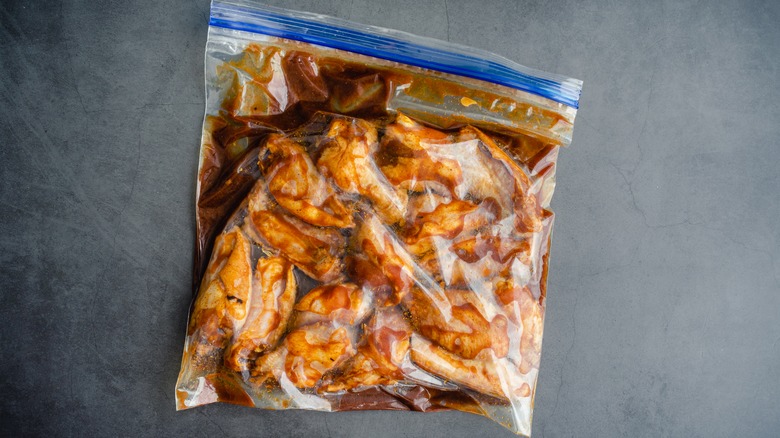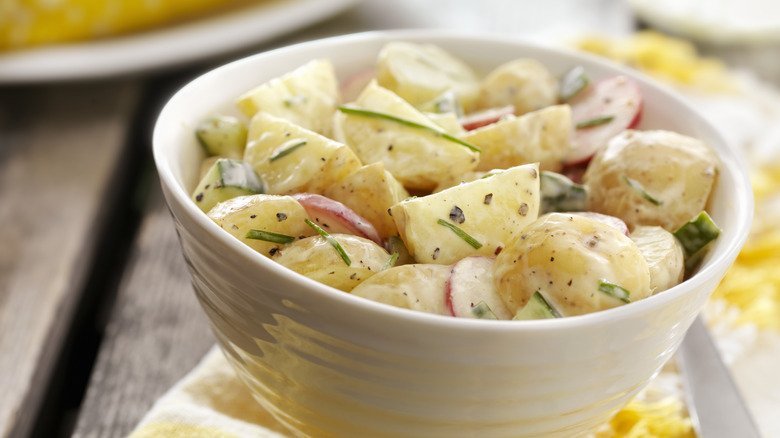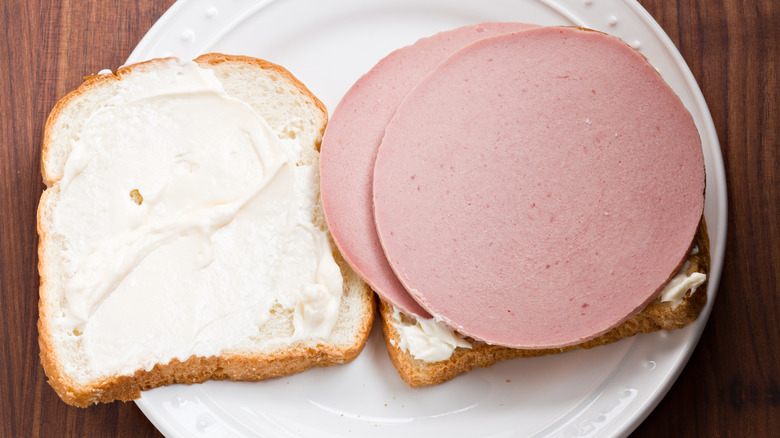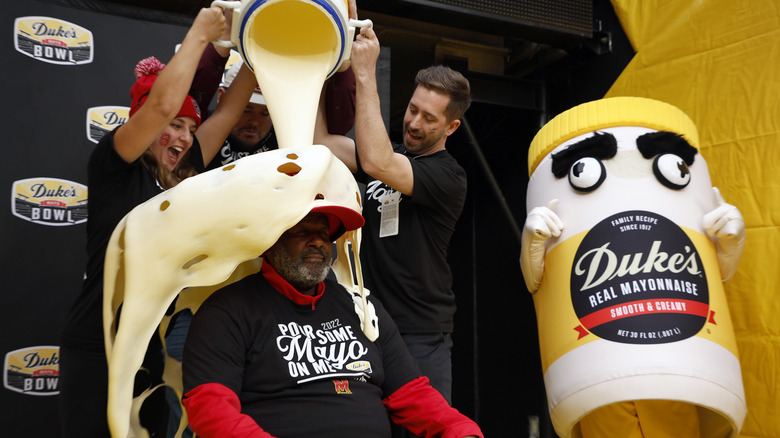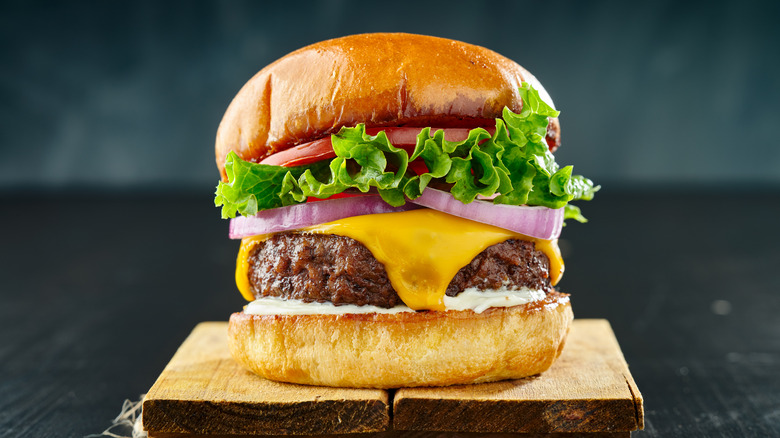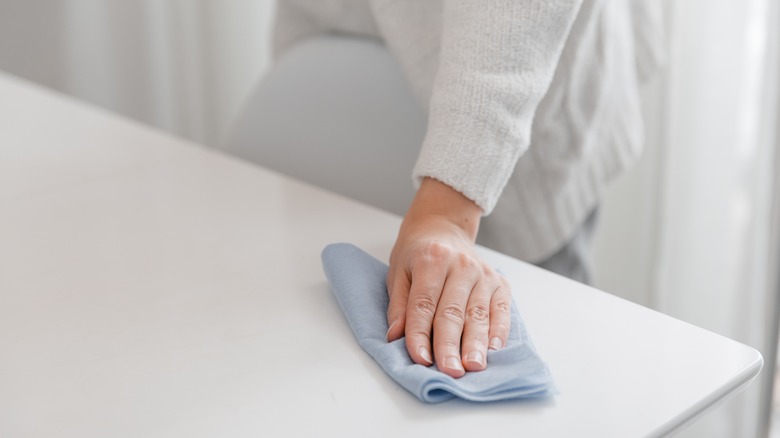Mistakes Everyone Makes With Mayonnaise
Mayonnaise can be a pretty divisive condiment. Some people love it and will eat it with anything — you can bet they have staunch beliefs regarding which brand is best (and don't even get them started on the sins of Miracle Whip). Others find mayonnaise just "meh." It's okay on a sandwich, but is it really the amazing condiment that diehard fans claim it to be? Then, there are the folks who wrinkle their noses in disgust at the site of the thick, white substance; if you're one of them, chances are you're not even reading this, because you won't be making any mistakes with mayonnaise. To you, the mistake would be eating the mayonnaise in the first place.
No, these tips, tricks, and warnings are for those who either love mayonnaise and want to make their experiences the best possible, or anyone on the fence about the condiment who wants to see what the hype is all about. These are the mistakes you're likely making with mayonnaise — and how to fix them.
You're not making it from scratch
Sure, making mayonnaise from scratch can seem intimidating. It requires so few ingredients — mostly just eggs and oil — yet through some crazy magic, they transform into a fluffy, thick substance that you can slather on your sandwich bun or use as a dip for your french fries. That said, while making homemade mayonnaise seems farfetched for the average person, it's really not. With a little practice and some extra gear (making mayo at home is infinitely easier with a food processor or blender, versus just a whisk and elbow grease), you can make your own mayo at home.
Just be sure you don't make one of the major mistakes that everyone makes when making homemade mayonnaise the first time. Use quality olive oil and let your eggs come to room temperature before making the mayo. Be sure not to rush the process either. And if you mess it all up and the mayonnaise breaks, rest assured that you can fix it by re-emulsifying the ingredients by adding a new egg and mixing anew.
You're not storing it correctly
If you made your mayonnaise from scratch, there's no question about it: You need to store it in the fridge. It's made with raw eggs, after all. Furthermore, the U.S. Department of Agriculture (USDA) recommends consuming homemade mayo quickly, within four days.
However, there's a lot of debate about whether or not you need to keep store-bought mayo in the fridge or if you can let it sit at room temp. We'll make it clear: Although store-bought mayonnaise is safe to leave unopened in the pantry, you'll want to pop it in the fridge as soon as you open it, according to the USDA, where it'll stay good for up to two months. (Yes, there are still some brands of mayo that say you can store them in the pantry after opening. However, that's still not desirable, as leaving the mayo unrefrigerated can cause changes in texture and color.)
You're using too much of it
Yes, we know. Too much mayo? How could there be such a thing? The more mayo, the better! Let it drip off the sides of your burgers and be the dominant flavor in your potato or pasta salads! However, there's one recipe where you don't want to use too much mayo: deviled eggs.
Mayonnaise is a requisite ingredient in classic deviled egg recipes, helping you achieve a smooth, creamy egg yolk filling to pipe back into your halved egg whites. Unfortunately, if you add too much to the filling, you'll end up making the mixture too runny and unsuitable for piping. On that note, when you're making something that's texture-reliant, like pasta or potato salad, it might be best to watch how much mayonnaise you're adding to the mix. While you may love the flavor, you might not be so keen about the texture when your barbecue side dish ends up more reminiscent of a mayo soup.
You're overlooking its baking potential
If you're any sort of mayonnaise fan at all (or just from the South), you probably know about mayonnaise cake. This baking recipe became popular in the early half of the 20th century when store-bought mayonnaise became more readily available. It's basically a super moist and decadent chocolate cake that includes just a touch of mayonnaise for extra moisture and creaminess.
That said, while mayonnaise cake is perfectly delicious, don't just limit your mayonnaise-baking adventures to cakes. You can use this condiment as a substitute for butter in an array of baking recipes, including brownies, cookies, and certain breads. The only instances where you wouldn't want to use mayonnaise in your baked goods is when butter is absolutely necessary and no other substitute will do. Think pastry crusts, butter cookies, and other foods that really rely on butter for a flaky texture and buttery sheen.
You're not adding it to scrambled eggs
Just like mayo can add a lush and velvety texture to your chocolate cake, it can also do the same to your scrambled eggs. In recent history, this mayo-scrambled egg hack has been brought into the limelight by Alton Brown, however, this hack is nothing new. A 1970s ad shared on a Reddit thread about old recipes displays a photo of "mayoneggs." The recipe was a mayonnaise ad for Best Foods mayonnaise, which is another, regional name for Hellmann's. And, no, it's not the mayonegg combination referenced in "Arrested Development," where a character eats an egg and then squeezes mayo in their mouth, as Vulture explains. Instead, the recipe just calls for a tablespoon of mayo for every two eggs you scramble.
This trick works for the same reason mayo works in certain baking recipes. As multiple Reddit users explained in a thread on the topic, mayo adds creamy fat to your eggs, much like butter or crème fraîche might, for a custard-like smooth scramble.
You're not using it in your marinades
If you think of mayo as being mostly fat, it just makes sense for it to take the place of butter in baking dishes or in your scrambled eggs. However, considering you don't often marinate meat in a vat of butter, you might not think mayo will work for marinating either. That is where you'd be wrong.
Mayo works as a marinade because once it's soaked into whatever item you're marinating, it can help prevent burning so the food cooks more evenly. Of course, it also lends that fat factor as well, imbuing a succulent flavor similar to what you might get from butter. Beyond that, since mayonnaise is more or less a mild, albeit distinct, flavor, it's the perfect vessel for other flavors. You can add in a range of spices, seasonings, and sauces to achieve a marinade that won't burn quickly, but that still boasts the flavors you want.
You're adding it too soon to hot dishes
While mayonnaise can certainly do a lot, it cannot stand up to extreme temperatures and still retain its characteristic thick texture. You can grill mayonnaise-based marinades without affecting the texture, and you can bake a mayonnaise-infused cake with successful results too. However, you're not expecting the texture of mayonnaise from those items — you're just looking for a creamy cake or a succulent side of meat. When you're making something that relies on mayo's distinct texture, like a potato or pasta salad, it's a different story.
In these cases, you likely want a sauce that's creamy, thick, and sticks to the individual ingredients. However, if you're making a mayo-based sauce and you add it to the hot potatoes or pasta right after you drain them, you're going to end up with a wet, broken, oily, thin sauce, all because of the heat. Since mayonnaise is an emulsion, the extreme heat will cause it to split, and you'll either be stuck with a broken sauce, or your other ingredients will absorb it, leaving you with a salad and no sauce to speak of.
You're not using enough of it on your sandwiches
There's nothing worse than putting together a truly delectable sandwich, picking it up for that first bite ... and having the sandwich fall apart in your hands because, somehow, it has developed a soggy bottom. Maybe you really piled on the tomatoes. Maybe your lettuce is a little wetter than you would've liked. Maybe the bread itself is just on the delicate side.
Whatever the case may be, an easy way to help build a protective layer on that bottom piece of bread is with extra mayo. The oily condiment helps keep any extra liquid from seeping into the bread. Then, you can layer on your other ingredients. If you're building a more traditional sandwich, add your meats and cheeses next, before topping with veggies or condiments. However, even if you're just making something simple, like a tomato sandwich, you'll still find that the mayo layer makes a big difference.
You haven't picked a mayo team
If you want to call yourself a real mayonnaise fan, you're going to have to pick a team. The mayonnaise brands with the most ardent fanbases include Duke's in the South, and Hellmann's just about everywhere. Another popular pick is Kraft Mayo. (And if you prefer Miracle Whip over all three of these, just don't tell any mayonnaise diehards.) The important thing is that you pick a side and stick with it. Try them all, find your favorite, and find your fanbase. Mayonnaise fans are fun, after all; Duke's even has its own mascot, Tubby, a literal tub of mayonnaise with oversized eyebrows.
Whatever your choice, if you are truly adamant about your dedication to mayonnaise, there's a good reason and science behind it. Mayonnaise, in part, makes our lizard brains happy. Filled with fat, our biological hardwiring recognizes it as a food that could give us much-needed energy and maybe even save our lives. Fat makes the brain release dopamine and, furthermore, the acid, salt, and other elements in mayonnaise hit the majority of the recognized taste receptors, for an all-around body-pleasing condiment.
You're not using it on your grilled cheese
Using mayonnaise in place of butter isn't just a popular choice when it comes to cake. Many use the condiment to cook grilled cheese sandwiches as well. The same factors that make mayonnaise a good fit for marinades and baking make it a good fit for frying your sandwich. The fat content plays the same role as the butter you might normally use. Also, just like mayonnaise helps marinated meats and other items cook evenly without burning, it also helps your bread out in the same way.
This method gets rave reviews from a lot of fans. Martha Stewart uses it and the Duke's mayo brand recommends it. However, some people say that rather than swapping out your butter for grilled cheese altogether, you should actually consider combining both. An Insider reviewer taste-testing Martha Stewart's method said doing so achieved a superior texture than using either option alone, for a crispy exterior and creamy interior.
You're not putting it in your burgers
In addition to marinating your grilled meats in mayonnaise, you can also use mayo in your homemade burger patties. According to a championship burger guru interviewed by The Washingtonian, adding mayonnaise to ground beef adds moisture and fat. Much like in a marinade, using mayonnaise with ground beef keeps the texture nice, moist, and fatty. Additionally, it doesn't interfere with the taste of the beef. The interviewee said they preferred Duke's mayonnaise for this use due to the higher egg content, and noted that if you have other brands at home, you can simply add an extra egg for the same effect.
Prefer a turkey burger to an all-beef patty? Southern Living clarifies that this tip will also work with turkey burgers, helping you avoid a dreaded dry patty. No mayonnaise on hand? You can achieve a similar, if not exactly the same result by adding similar creamy ingredients, like sour cream or yogurt.
You're not using it as a cleaning agent
Mayonnaise? For your cleaning? Normally your first reaction might be to avoid getting mayonnaise on anything that's not a sandwich or potato salad, but why not smear it on some of your furniture, too?
No, really — mayonnaise comes in useful in an array of cleaning situations. The oily base is good for removing pesky sticker residue, as well as other sticky things, like tar, chewing gum, and tree sap. Similarly, the oil can add a sheen to your fake houseplants (just go a little easy on the mayo as you're applying it — otherwise you may find that the family dog has taken a sudden and severe interest in your fake plants). Some say the oil and lemon in mayo make the condiment a good choice for polishing your wooden furniture — though you may want to test it out in an inconspicuous spot before committing to polishing up every piece in the house — as well as for polishing your silver.
